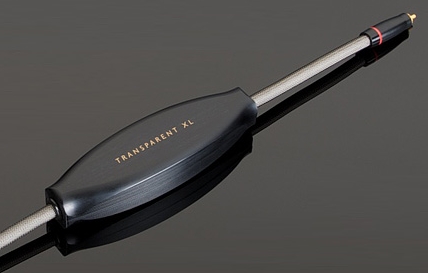Ed's
AV Handbook
Batting Practice for the AV Professional
and primer for the novice
Chapter
5 Page 3
The AV System Sequence
Cable & Interconnects
A controversial Subject
The AV system
sequence cannot exist without
interconnecting wire and cable.
Although constructed of metal wire
conductors and insulation, an AV
signal does not merely travel through
the metal conductor. The AV
signal is an electromagnetic wave that
propagates along the metal conductor
within its insulator boundary.
Cable and interconnects fundamentally
behave as wave-guiding conduits.
These extended conduits, the longest
circuits of an AV system, must
negotiate the same obstacles as the
shorter circuits in AV
components. These obstacles
include noise, resonance, resistance,
inductance, and capacitance.
Noise
As acoustic noise
in a room, electromagnetic noise can
bleed in and out of an electrical
environment. For example, long
parallel strands of wire in an
interconnect or speaker cable can
behave as an antenna that attracts
and generates electromagnetic
noise.
Also, similar to problematic
acoustical reverberation, the impeding
electrostatic force within the cable
can also temporarily trap and randomly
release bands of audio out of
phase from the balance of the
original waveform. Random sound
is noise.
Resonance
The management of resonance is a frequent theme in audio. It is a function of how electrical inductance or acoustical mass plus capacitance responds to fluctuating low-frequency energy. In acoustics, this defines room modes or standing waves. In an electrical circuit, it is electrical resonance. Unwanted resonance creates deviations from flat frequency response. The result distorts audio. Resistance, inductance, and capacitance are the fundamentals that set the electrical resonance table.
Resistance
Resistance is a
process that converts impeded
acoustical or electrical
low-frequency energy to heat.
Walls resist acoustical energy.
As sound energy increases,
mechanically (slightly bending)
resisting walls covert waves of
acoustical energy to heat.
Electrical current flows initially
along the surface of a wire. As
the current increases, it will
ultimately penetrate and saturate the
cross-section of each conductor.
Resistance to the flow rapidly swells
and converts the electrical
energy to heat. Great
engineering-design for a toast-heating
element. But not for audio.
Inductance
Room boundaries create and define an acoustical-field. Magnetic fields establish the boundaries of an electrical circuit. Though they are not as tight as an electromagnet, speaker wire and interconnects are still coiled parallel circuits that also create a magnetic field. The magnetic flux in this field defines inductance. Inductance impedes electrical energy.
Capacitance
Room boundaries form a vessel that can hold an acoustical spring of low-frequency energy. Inductive magnetic-boundaries also store low-frequency energy as an electrical spring of electrical-energy. This spring-like potential that stores and impedes low-frequency energy defines capacitance.
The Reactance Resonance Dance.
Inductance is the force that squeezes the capacitance spring. Resistance sets the table for each. The resistive spring-like interaction between inductance and capacitance describes reactance. When inductive reactance equals capacitive reactance, it produces a ringing peak. This ringing resonant frequency creates deviations in frequency response, distortion. This electrical interaction also bandpass, trap, stores, and randomly releases energy. It is the random electrostatic noise mentioned earlier.
Solutions
You cannot
eliminate all sources of noise, resistance,
the resonance
impeding reactance forces of
capacitance and inductance. But
careful design choices can minimize
their distorting effects.
For instance, many strands of pure
copper, silver, or silver-coated
copper can reduce resistance, which
translates into a better transfer of
energy. Polypropylene insulation
infused with air pockets can reduce
capacitance, which can minimize the
inductance-capacitance spring-like
interaction. Shielding and or
interleaving of insulated conductors
referred to as twisted pair geometry
can reduce noisy antenna effects.
The electrical dilemma is each design
choice affects the other. More
insulated strands can increase
inductance and capacitance, less
increase resistance. The noise
shield coiled-like interleaving of
twisted-pair geometry can shift the
reactant resonant peak point to an
undesirable frequency.
Quality cable manufacturers work the
problem with the same strategies
utilized in speakers, acoustics, and
all electronic components. They
select a recipe mix of resistive,
capacitive, and inductive trade-offs
that fulfills their performance
trade-off goals.
Many cable and interconnect
manufacturers augment twisted-pair
techniques by limiting cable bandwidth
with a low pass filter network.
Many vary twisted-pair
design-techniques that realign the
phase of bass-frequencies with the
band passed high frequencies.
Some also augment phase alignment and
re-tune resonant peaks to a less
offensive point within the filter
network.
The Important Point
Negotiating noise and unwanted impeding reactant resonant forces with an audio-video interconnect or speaker cable is a mix that seeks to minimize the compromise that confronts the same physics found throughout the AV system sequence. Therefore, select speaker cable and AV interconnect with the same consideration given to room acoustics and the system components.
Select this line to Ed's AV Blog for a more controversial account of this subject.
Ed's AV Handbook
Copyright 2007 Txu1-598-288 Revised 2024
Sponsored By

Architectural Speaker Tuning System
Site Menu
Home
Table of
Contents
Handbook Chapters
1 AV
Terms
2 AV Physics
3 Sound Reproduction
4 Video Reproduction
5 The AV System Sequence
6 The Room, Speaker, & TV
7 Acoustical Strategy - Small Room
8 Home Theater by Design
9 AV Sales Training
10 AV Business & Marketing
Contact
About
